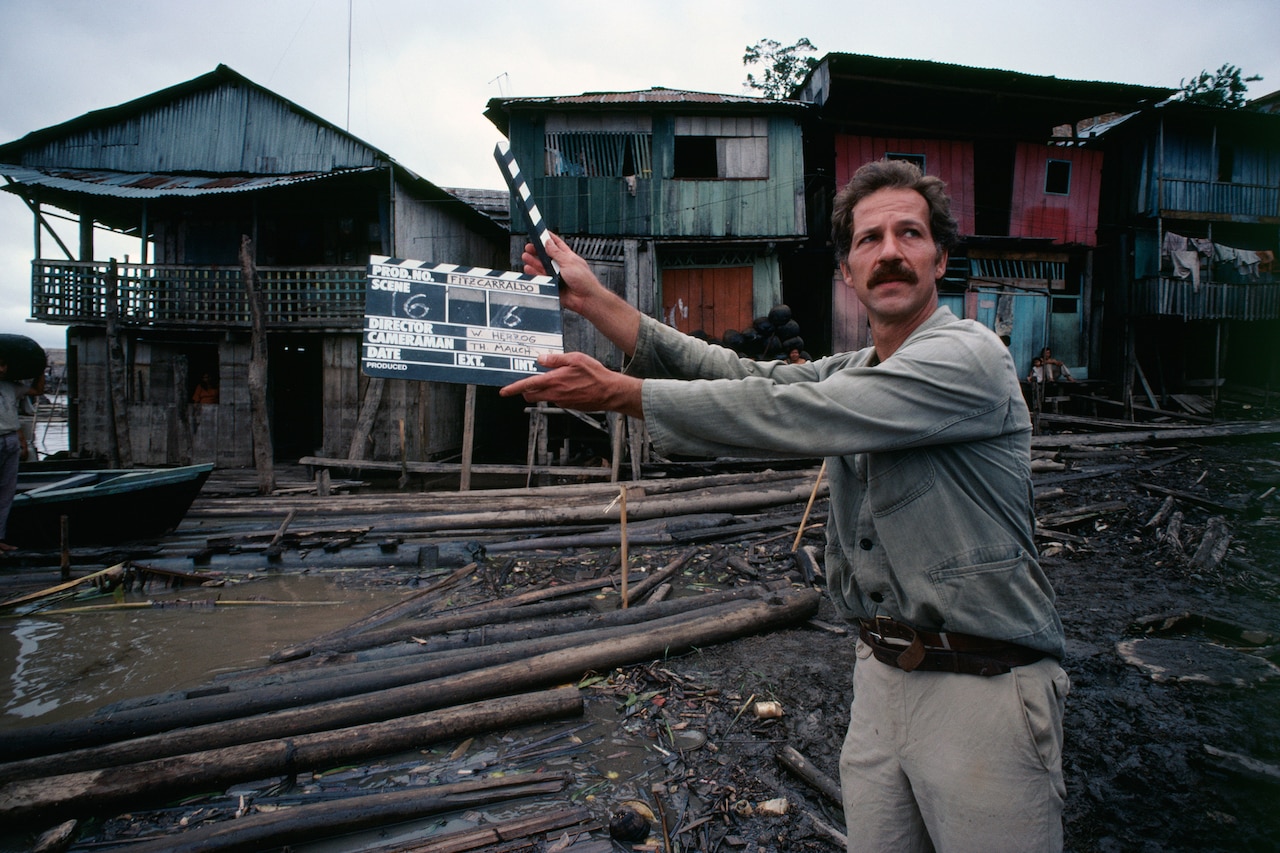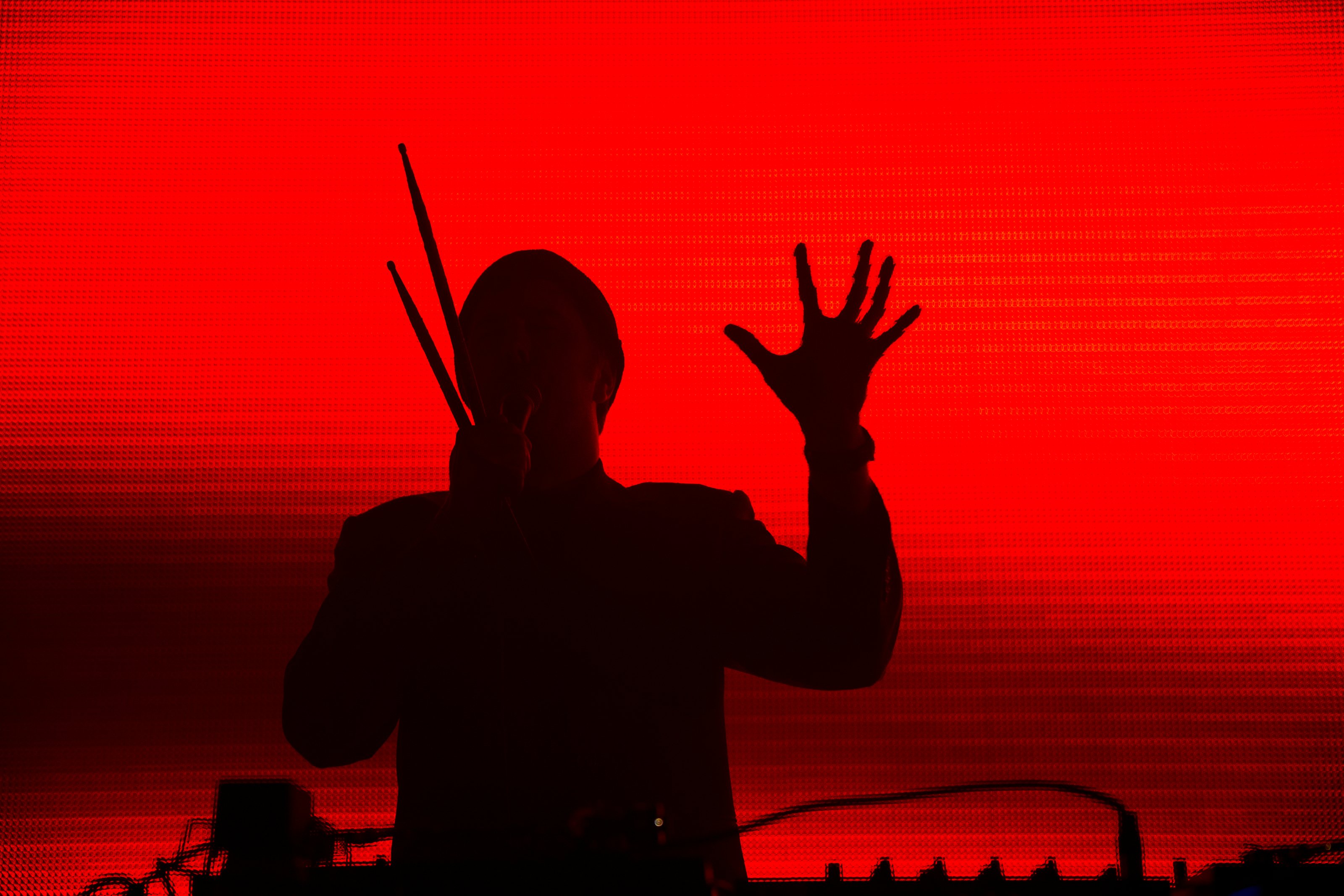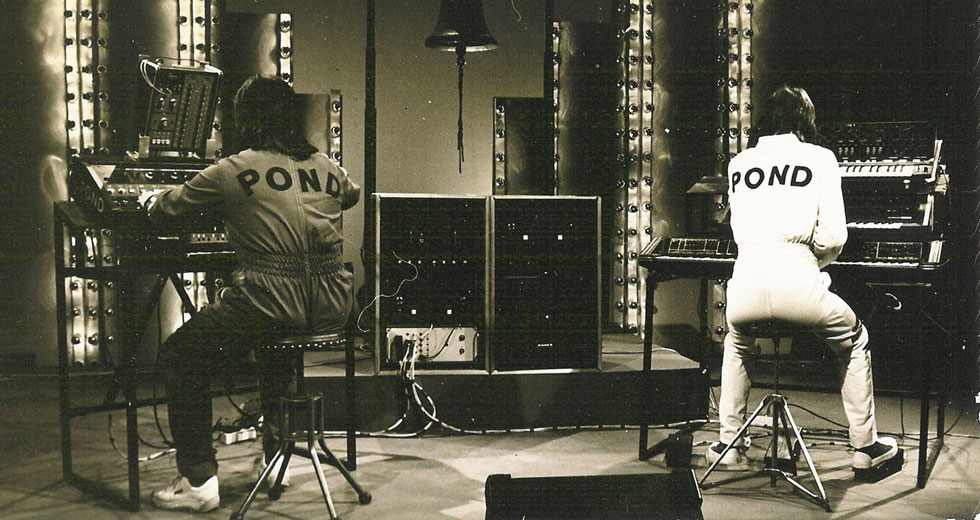
Between Heaven and Hell: Florian Fricke & Werner Herzog
Examining the powerful collaborations of the transcendentalist musician and iconic filmmaker
The marriage of Popul Vuh’s music and the films of Werner Herzog was one made in heaven and hell. It was a marriage of opposites – of temperance, spiritually luminous optimism and high-mindedness and moral squalor, dark excess and despair – but also like minds. Both artists were forged in West Germany, but their perspective was unconfined and international.
Formed in 1969, with their leader Florian Fricke managing to obtain a Moog synthesizer long before such instruments were available to his peers, Popul Vuh are rightly considered foundational to the Krautrock phenomenon. Fricke’s credentials were impeccable: Born in the Bavarian island town of Lindau in 1944, he was introduced to the piano as a child. “I began to make music when I was 11,” he told Sandy Robertson of UK magazine Sounds in 1981. “Classical piano. I went to a special high school for music when I was 15, though people usually go there when they’re 20 or so. But my father convinced the authorities of the school that I was ready.” He continued his studies in Freiburg and later Munich, claiming his life’s work to be in the tradition of Mozart and early polyphonic music, and among his tutors was the brother of the great 20th century composer Paul Hindemith.
Fricke’s head was turned slightly from his studies, however, by his interest in film, which was producing a radical new crop of auteurs – Krautfilm, so to speak, though no one ever had the poor taste to coin such a phrase. One of his first paying jobs was as a film critic, for Der Spiegel among others. He was also inevitably touched by the insurrectionary spirit of the 1960s, but it was one aspect of that time in particular that affected him, as radical young Germans turned against their American economic benefactors, revealed as imperialists by their involvement in Vietnam. As Fricke told his friend Gerhard Augustin, to whom he granted a rare interview in 1996, “There was also a spiritual revolution. We have discovered the Eastern part of this globe.”
If Krautrock was about beginning again, Fricke was resolved to cast back his mind to the very beginning of creation.
There was certainly an interest in Eastern culture among the more hirsute wing of 1960s German youth, for various reasons – as a riposte to the hegemony of the West, as an exotic alternative, for its cultures whose mantras and drones provided a perfect accompaniment to the ingestion of drugs or simply to follow the path taken by The Beatles, much as so many young German people had done in the earlier part of the ’60s and the beat music era.
Fricke, however, wanted to look further and go deeper. The epiphany he experienced when he came across the old Mayan book – from whose title Popol Vuh (“Book Of The Community”) took their name – hit home “like a thunderstorm,” he said. If Krautrock was about beginning again, Fricke was resolved to cast back his mind to the very beginning of creation, fired up by the beautiful, founding myths of this lost South American people. He didn’t fixate exclusively on the Popol Vuh, however – he also found inspiration in the Bible and the Bhagavad Gita, the 700-word Hindu scripture in which Krishna imparts the doctrine of the path to devotion.
Werner Herzog, by comparison, had staggeringly little in the way of musical training, or indeed exposure to music as such. Born in 1942 in Munich, he was one of a generation whose early upbringing was spent among the ruins of postwar Germany. This, however, was less a trauma, more of a playground. As he later explained to Psychology Today: “People think growing up in the ruins was such a bad thing for children. On the contrary, it was wonderful. We were the kings of bombed-out blocks in the cities.” He was barely aware of cinema as he played amid the rubble, until a travelling projectionist came to his schoolhouse.
When he was 12, he was asked to sing in front of his class and for some reason – the coercion, perhaps – he adamantly refused. For the next several years Herzog took against music entirely, neither playing nor listening to it, though he later wished he had spent those years playing the cello. It’s perhaps because of this schism, rather than despite it, that music would play the role that it did in his films – intermittent, but telling and precious when featured.
In his youth he developed a wanderlust, setting off on long journeys, walking if necessary. Much as Florian Fricke’s music spans the globe in its internationalist, spiritual preoccupations, so did Herzog find himself in far-flung parts of the world as a filmmaker – Africa, Peru, the Amazon, Yellowstone Park. Unlike some of his peers in the New German Cinema, Herzog did not take for his subject matter his home country in his own time. And yet, as an artist, he was unavoidably shaped and catapulted into the world by both.
Fricke first met Herzog in 1967, during his days as a film critic. He was impressed by his drive, his ability to achieve the improbable – later reflected in the themes and contents of films like Fitzcarraldo – and that Herzog had been unaffected by his fame, testimony to his single-mindedness and strength of character. They seemed destined to meet – after all, Herzog himself had used the text of the Popul Vuh as the basis for one of the chapters of his Fata Morgana, shot in 1968 and 1969, which in its structure, recurring motifs and the starring role in which landscape plays made for a “Krautrock” experience on celluloid.
In 1968, Fricke appeared as a pianist in Herzog’s Signs Of Life. He would later be cast at the keyboard by the director in The Enigma Of Kaspar Hauser. It seems that during the shooting of that film in 1974, Herzog happened to be hanging out at Fricke’s house while he was playing the piano. He was improvising, eyes fixed on the wall ahead of him, not on the keys. Herzog commented that he was playing “blind,” and an idea hatched. A few days later Florian received a call asking him to come to the set: Herzog had decided to incorporate a part for Fricke as the blind and orphaned piano player.
The scene in which Hauser’s character looks on as Fricke plays his song “Agnus Dei” is one of the film’s most memorable, if not absolutely integral. In a drawing room which has all the piety of a Jan Vermeer setting, Fricke pounds out the song with a religious intensity, like an Eastern incantation. Clearly, the character of Professor Daumer, looking on, finds the music “a little strange” in its intensity, which fills Hauser with wistful longing. Kaspar is a type to which Herzog exhibited a Diane Arbus-like fascination in his films, not unlike the rebellious little people in 1970’s Even Dwarves Started Small (for whose barely-existent soundtrack Fricke receives a credit); it feels like we are at once invited to goggle at their strangeness but also be struck by their extra-human qualitie – they do not fit in with the temperate, restrictive norms of everyday society. Fricke’s cameo appearance as the blind, orphaned yet obsessively dedicated pianist is the perfect adjunct to this theme.
From 1972 onwards, Fricke and Popul Vuh were responsible for the soundtrack to a number of key Herzog movies. As Robert Barry pointed out in The Quietus, these were not conventional soundtracks of, say, the Bernard Herrmann variety, in which a running commentary is provided on the characters and drama. Rather, Barry observes, the soundtrack acts “as a kind of overture or intermezzo” – a succession of interludes whose effect is all the more memorable for their intermittence.
What’s particularly striking about the Popul Vuh soundtracks is the counterpoint they provide to Herzog’s films. Popol Vuh’s music, in accordance with Frick’s transcendental, spiritual concerns as exhibited on albums like In Den Gärten Pharaos (1971) and Hosianna Mantra (1972), is all about ascension – to a higher, unsullied place, up into the light, departing ever further and upward from Krautrock’s electronic, noisenik tendencies. Fricke eventually gave away his Moog synthesizer to Klaus Schulze, concentrating on his beloved piano and creating a religiously inspired music which aspired to the same sonic spheres as the old German masters.
Herzog’s films, by contrast, are Conradian in their preoccupation with descent into the darkness, into the terrible, wilful folly and squalor of the human soul. He had once said that he would go down to hell and fight with the devil himself in order to make his films. This was embodied in Klaus Kinski, the man Herzog described as his “best fiend,” an Antichrist of sorts who with his unkempt shock of blonde hair sometimes resembled Johnny Rotten, and certainly more than matched his balefulness. (He also, oddly, resembles a more demonic, craggy version of Florian Fricke.) Allegations that have come to light since Kinski’s death from his daughters, including the actress Nastassja Kinski, of sexual abuse and attempted rape, only boost the grave suspicion that, regardless of his force as a screen icon, he was a debased and terrible man. Indeed, it’s an uncomfortable possibility that a debased nature was one of the reasons for his onscreen power.
“Too much the darkness,” Fricke once muttered of the travails and disasters that were part and parcel of the making of any Herzog movie.
The descent is quite literal in two of the films soundtracked by Fricke and Popul Vuh – Aguirre, The Wrath Of God, made in 1972, for which Popul Vuh provided their first soundtrack proper for a Herzog film, and Fitzcarraldo. Aguirre is set in the 16th century, following the annihilation of the Incan empire. It follows the journey of a band of conquistadors, including Kinski as Don Lope de Aguirre, as they set out in search of the mythical El Dorado, the City of Gold, a myth invented by the native South Americans they subjugated. The voyage is a hazardous and treacherous one, driven by delusion, greed and conceit, a doomed journey in search of a nonexistent place. Fitzcarraldo is set in the middle of the jungle around the turn of the last century and tells the story of Brian Sweeney Fitzgerald’s preposterous dream of staging an opera bringing together Sarah Bernhardt and Enrico Caruso. To raise the money for this venture, he must reach and exploit a vast area of rubber trees beyond the Ucayala Falls, hauling his steamboat over a mountain with the assistance of Indian tribes, who are so mesmerized by the gramophone recordings of the great singers that they willingly put themselves at the white man’s service.
Everything about these tales runs in precisely the opposite direction to the music of Popul Vuh. (“Too much the darkness,” Fricke once muttered of the travails and disasters that were part and parcel of the making of any Herzog movie.) Fricke’s music aspires towards heaven, whereas Fitzcarraldo and Aguirre are on a downward path, down the slopes of the Andes, through churning mud and the difficult headwaters. Popul Vuh’s music actively celebrates and pays homage to other cultures and their equal, relative value to Western Christianity, while Aguirre is an imperialist conqueror of native peoples and Fitzcarraldo a man with no qualms about achieving wealth on the backs of the “savages” he exploits, impressing on them the dominance of his own, “higher” culture (opera) as he does so. Popul Vuh’s music strives for spiritual fulfilment, beyond the bounds of earth; Aguirre and his conquistadors descend deep into its most hellish thickets in search of fool’s gold.
Perhaps it’s precisely because of its antithetical nature that Popul Vuh made for such an ironically appropriate soundtrack to these films. Herzog admiringly described the Mellotron-like device which dominated the soundtrack to Aguirre as a “choir-organ,” containing dozens of individual vocal loops which could create an unearthly choral effect, as if the angels themselves were looking down on the proceedings of the drama with great sadness. Or, perhaps it is simply that the music solemnizes, bestows a sort of church blessing to Herzog’s own artful and arduous efforts to make these movies, his struggles matching those endured by the characters. Certainly, movie critics such as Roger Ebert were moved to remark on the mesmeric qualities of these soundtracks, which might well have been their single acquaintance with Popol Vuh or any German music of that era.
Effective in a different way was Popol Vuh’s soundtrack for Nosferatu The Vampyre, released in 1979, in which Kinski this time invites a measure of pathos as a Dracula who keenly feels his loneliness. It’s here that the light and shade of Popul Vuh’s music really comes into its own. Fricke provides pretty, string-soaked background for the pastoral scenes. However, his high, Gothic strains also enhance the more beguilingly terrifying passages of the film – the opening scene, for one, filmed in the Mummies of Guanajuato Museum, Mexico, in which the rotten, mummified remains of victims of an 1833 cholera epidemic are frozen forever in expressions of horror at their own mortality, teeth bared, eye sockets voided. Or, the electric blue sequences in which Nosferatu assumes the form of a bat as he makes his attacks, or that of a boat carrying a cargo of coffins downriver for transport to Wismar. As the camera wheels down on that boat, we see Nosferatu has killed the entire crew, the last of them dead and slumped over the ship’s wheel, to which he has lashed himself.
Each of these scenes is accompanied by a simple but devastating two note choral leitmotif from Fricke which, once heard, is never forgotten, and which helps engrave the key images from Herzog’s movie on the memory. All of his powers seem to be summoned into this single, magnificently appalling phrase, pointing like the bony finger of Giacometti’s sculpture L’Homme au doigt towards the horror.
There’s descent too in 1976’s Heart Of Glass – the documentary footage of tumbling waters that accompanies the gloomy seer Hias’s visions of global destruction, as the world “tumbles, falls, crumbles and collapses.” Popol Vuh’s soundtrack, however, does not evoke apocalypse but sparkles with a benign beauty, which provides a spiritual counter-argument to the pessimism of Herzog’s vision, implying that there is always hope for humanity over the horizon.
There’s a similar use of music as a reproach to the characters in Cobra Verde, in which Klaus Kinski again stars as da Silva, a bandit forced to turn his hand to slave trading in East Africa, eventually succumbing to the odds and the turn of history. The soundtrack of sober, stringed drones, Arvo Pärt-like, affords da Silva some pathos, but the incorporation of “Die Singende Mädchen” is visually accompanied by mocking, vivacious eyes of young African women, as the chant defiantly implies that the future, and the emancipation it brings, is theirs.
Although Popol Vuh’s Herzog soundtracks work admirably as standalone albums in their own right, it’s arguably as an enhancement to the difficult, morally mazy but deeply rewarding works of the great auteur of New German Cinema that Popol Vuh achieve their greatest purpose and impact on a wider audience. For those who find Fricke’s later musings on spirituality somewhat vapid and New Age-y, his music has a tangible and meaningful dramatic impact. Fricke and Herzog were all the better as artists for having collaborated – theirs was an artistic marriage between heaven and hell, to be sure, but one that bridged the gap between the two with undeniable success.
Header image © Jean-Louis Atlan/Sygma/Getty Images

